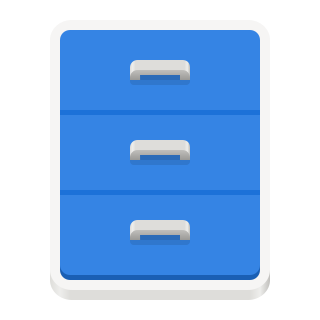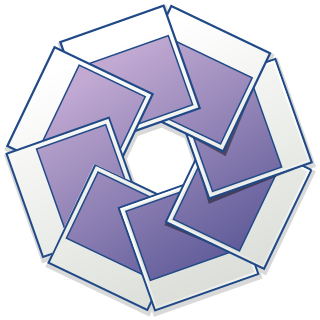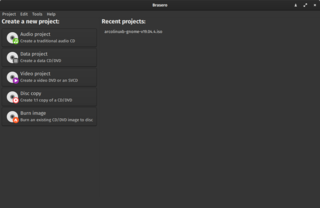In computing, a desktop environment (DE) is an implementation of the desktop metaphor made of a bundle of programs running on top of a computer operating system that share a common graphical user interface (GUI), sometimes described as a graphical shell. The desktop environment was seen mostly on personal computers until the rise of mobile computing. Desktop GUIs help the user to easily access and edit files, while they usually do not provide access to all of the features found in the underlying operating system. Instead, the traditional command-line interface (CLI) is still used when full control over the operating system is required.

GNOME Files, formerly and internally known as Nautilus, is the official file manager for the GNOME desktop. Nautilus was originally developed by Eazel with many luminaries from the tech world including Andy Hertzfeld (Apple), chief architect for Nautilus. The nautilus name was a play on words, evoking the shell of a nautilus to represent an operating system shell. Nautilus replaced Midnight Commander in GNOME 1.4 (2001) and has been the default file manager from version 2.0 onwards.

Java Desktop System, briefly known as OpenSolaris Desktop, is a legacy desktop environment developed first by Sun Microsystems and then by Oracle Corporation after the 2010 Oracle acquisition of Sun. Java Desktop System is available for Solaris and was once available for Linux. The Linux version was discontinued after Solaris was released as open source software in 2005. Java Desktop System aims to provide a system familiar to the average computer user with a full suite of office productivity software such as an office suite, a web browser, email, calendaring, and instant messaging.

Free and Open source Software Developers' European Meeting (FOSDEM) is a non-commercial, volunteer-organized European event centered on free and open-source software development. It is aimed at developers and anyone interested in the free and open-source software movement. It aims to enable developers to meet and to promote the awareness and use of free and open-source software.
Eazel was an American software company operating from 1999 to 2001 in Palo Alto and then Mountain View, California. The company created the Nautilus file manager for the GNOME desktop environment on Linux, which was immediately adopted and maintained by the free software community beyond the company's lifespan. Renamed to "GNOME Files", this application is an early example of cloud storage services and continues to be a centerpiece of the Linux desktop environment.

F-Spot is a slowly maintained image organizer, designed to provide personal photo management for the GNOME desktop environment. The name is a play on the word F-Stop.
A desktop environment is a collection of software designed to give functionality and a certain look and feel to an operating system.

GNOME Panel is a highly configurable taskbar for GNOME. It formed a core part of the GNOME desktop in versions 1.x and 2.x. It has been replaced in GNOME 3.x by default with GNOME Shell, which only works with the Mutter window manager.

LXDE is a free desktop environment with comparatively low resource requirements. This makes it especially suitable for use on older or resource-constrained personal computers such as netbooks or system on a chip computers.
In computer science, the Semantic Desktop is a collective term for ideas related to changing a computer's user interface and data handling capabilities so that data are more easily shared between different applications or tasks and so that data that once could not be automatically processed by a computer could be. It also encompasses some ideas about being able to share information automatically between different people. This concept is very much related to the Semantic Web, but is distinct insofar as its main concern is the personal use of information.

Tracker is a file indexing and search framework for Linux and other Unix-like systems. It is written in the C programming language.

Brasero is a free and open-source disc-burning program for Unix-like operating systems, it serves as a graphical front-end to cdrtools, cdrskin, growisofs, and (optionally) libburn. Licensed under the terms of the GNU General Public License.
NEPOMUK is an open-source software specification that is concerned with the development of a social semantic desktop that enriches and interconnects data from different desktop applications using semantic metadata stored as RDF. Between 2006 and 2008 it was funded by a European Union research project of the same name that grouped together industrial and academic actors to develop various Semantic Desktop technologies.

Empathy is an instant messaging (IM) and voice over IP (VoIP) client which supports text, voice, video, file transfers, and inter-application communication over various IM communication protocols.
Strigi was a file indexing and file search framework adopted by KDE SC. Strigi was initiated by Jos van den Oever. Strigi's goals are to be fast, use a small amount of RAM, and use flexible backends and plug-ins. A benchmark as of January 2007 showed that Strigi is faster and uses less memory than other search systems, but it lacks many of their features. Like most desktop search systems, Strigi can extract information from files, such as the length of an audio clip, the contents of a document, or the resolution of a picture; plugins determine what filetypes it is capable of handling. Strigi uses its own Jstream system which allows for deep indexing of files. Strigi is accessible via Konqueror, or by clicking on its icon, after adding it to KDE's Kicker or GNOME Panel. The graphical user interface (GUI) is named Strigiclient.

GNOME is a free and open-source desktop environment for Unix-like operating systems. GNOME was originally an acronym for GNU Network Object Model Environment, but the acronym was dropped because it no longer reflected the vision of the GNOME project.

GNOME Shell is the graphical shell of the GNOME desktop environment starting with version 3, which was released on April 6, 2011. It provides basic functions like launching applications, switching between windows and is also a widget engine. GNOME Shell replaced GNOME Panel and some ancillary components of GNOME 2.

Unity is a graphical shell for the GNOME desktop environment originally developed by Canonical Ltd. for its Ubuntu operating system, and now being developed by the Unity7 Maintainers (Unity7) and UBports (Unity8/Lomiri). Unity debuted in the netbook edition of Ubuntu 10.10. It was initially designed to make more efficient use of space given the limited screen size of netbooks, including, for example, a vertical application switcher called the launcher, and a space-saving horizontal multipurpose top menu bar.

MATE is a desktop environment composed of free and open-source software that runs on Linux and BSD operating systems. An Argentine user of Arch Linux started the MATE project to fork and continue GNOME 2 in response to the negative reception of GNOME 3, which had replaced its traditional taskbar with GNOME Shell. MATE aims to maintain and continue the latest GNOME 2 code base, frameworks, and core applications.

Cinnamon is a free and open-source desktop environment for the X Window System that derives from GNOME 3 but follows traditional desktop metaphor conventions. Cinnamon is the principal desktop environment of the Linux Mint distribution and is available as an optional desktop for other Linux distributions and other Unix-like operating systems as well.












